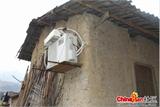Those who pay for their own flight training can earn 4 million yuan in 10 years
March 16, 2008, 21:10:24, China Finance Network
A pilot in the cockpit. (Photo by reporter Ping Shi)
Yesterday, China Southern Airlines announced that it will recruit 300 self-funded flight students nationwide in 2008. This is the third domestic airline to announce recruitment of self-funded flight students since March this year. Due to recognition from national regulatory agencies, aviation companies, and trainees alike, industry insiders believe that self-funded flight training will become a development trend for the cultivation of pilots in China.
Monthly Income Reaches 14,000 Yuan After Six Months of Flying
According to the introduction, after passing the selection exam by China Southern Airlines, students will undergo 27 months of training at either the Flight College of Beijing University of Aeronautics and Astronautics or the Civil Aviation Flight University of China. They will then be assigned to various flight units under China Southern Airlines to participate in international, domestic, and regional route flights. Their welfare benefits will be the same as those of "public-funded" pilots. According to China Southern Airlines, typically after participating in flights for six months (transitioning to the first co-pilot), monthly income can reach around 14,000 yuan.
All costs for flight training and miscellaneous fees are borne by the students, approximately 700,000 yuan. Students can apply for personal loans up to 702,000 RMB based on their financial situation, with China Southern Airlines providing joint guarantees with the student's parents. However, China Southern Airlines disclosed that about 10% of the students are eliminated after entering school and cannot obtain a diploma upon completion of training. After being eliminated, China Southern Airlines cannot guarantee employment for them.
Pilot Shortage in Private Companies
It was learned that Shenzhen Airlines recently completed its two rounds of interviews for self-funded flight student recruitment in Zhengzhou and Shenzhen during the first half of the year. Sichuan Eagle Airlines also announced earlier this month that in response to the rapid expansion of its fleet, it plans to recruit 50 self-funded flight students from society this year, becoming another domestic airline to test the self-funded pilot training model.
Due to a lack of talent reserves, companies like Eagle Airlines, Dongxing Airlines, and Spring Airlines had no choice but to poach pilots at high prices from traditional airlines during their early operations. The frequent incidents of pilot "job-hopping" and the substantial "compensation claims" from the original companies were seen as potential safety hazards for civil aviation. In 2005, the Civil Aviation Administration issued relevant documents stipulating that airlines recruiting pilots must pay transfer fees ranging from 7 million to 21 million RMB and must obtain approval from the original company. This indirectly prevented private airlines from poaching pilots from state-owned airlines.
To break out of this predicament, private airlines began trying various channels for pilot recruitment, such as hiring former air force personnel, introducing foreign pilots, and adopting both self-funded and public-funded models for pilot training. Among these, financially stronger companies like Shenzhen Airlines have opted to establish their own flight schools for custom training. Its Kunpeng International Flight School began operations last year, and currently has five trainer aircraft in place.
Self-Funded Flight Training Becomes a Trend
After private airlines took the lead in experimenting with self-funded flight training, China Southern Airlines also announced last year that it would recruit 100 self-funded flight students from society for the first time, attracting over 4,000 applicants nationwide. Ultimately, they successfully absorbed 151 outstanding flight talents.
In recent years, more young people have been choosing to pursue self-funded flight training. According to the recruitment office of Shenzhen Airlines, among the 307 flight students recruited last year, all voluntarily chose the self-funded option when deciding between self-funded and public-funded training. Despite the significant cost, due to loan guarantees provided by the enterprise and the fact that pilots generally earn between 3 million to 4 million RMB in total income over ten years, the financial burden is not considered too heavy. More importantly, the self-funded approach allows one to gain "freedom" faster, making it easier to switch jobs. It is understood that the service years agreed upon by Shenzhen Airlines, China Southern Airlines, and self-funded students are generally around 15 years.



